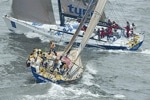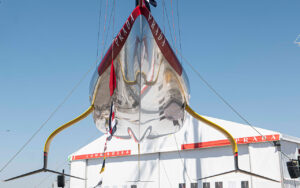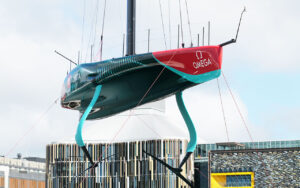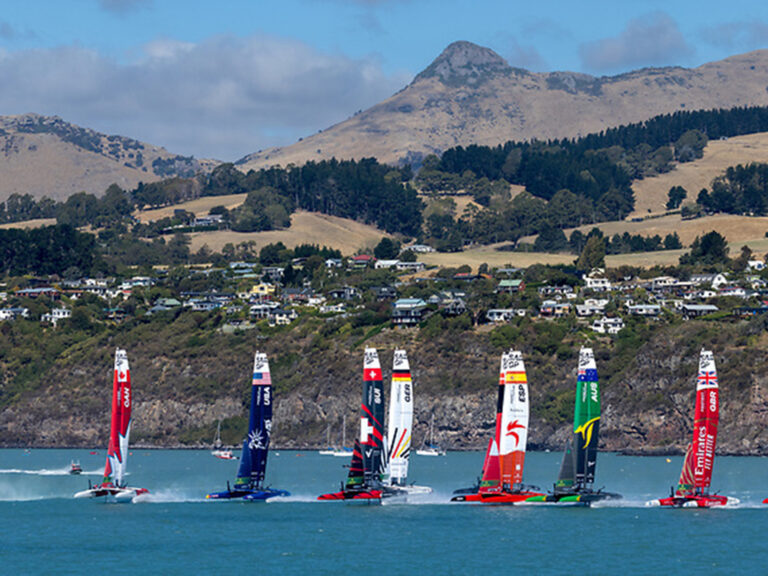
Sailing World editor John Burnham journeyed to the Chesapeake for the re-start of the Volvo Race and shares his impressions of the event.
A Volvo View
Several fine days of Maryland spring weather were interrupted Saturday night by a series of steady rain showers and limited visibility. Such was the weather mode when the eight Volvo 60s in Annapolis Harbor took to the Chesapeake Bay to start Leg 7 of the Volvo Ocean Race. From my vantage point aboard the race committee boat, the beautiful schooner Pride of Baltimore II, there wasn’t much to see as we headed out about 8:30 a.m. The fog was thick enough that for quite some time we couldn’t see the Bay Bridge, which we had to pass under to set up the start line to its north. Although the rain didn’t stop until after the 1:00 p.m. start, the soup cleared enough that we could see the arrival of a spectator fleet that eventually numbered several hundred, if not a thousand. %image1%
Two days earlier we’d sailed under this bridge en route from Baltimore to Annapolis with a number of media and sponsor types aboard the Norwegian Volvo entry, djuice.com. We’d enjoyed a sunny sail, powering along at up to 11 knots on a close reach in close company with the other Volvo 60s, which now that I’ve sailed aboard one I can report are unique racing boats. When fully loaded up with something like 5,000 pounds of water ballast in its windward tanks–roughly the equivalent of 20 pro football players on the rail–the helm doesn’t have much feel. Given the size of the mainsail and the purposefulness of the hull and deck layout, you kind of expect a jumpy, twitchy boat, but with the ballast in, it wasn’t anything like that. The helm sure loads up in a puff if the sails aren’t eased, but the rudder’s so deep that you can lean into the wheel and just hold it on course without a problem. The speed would build up over 10 knots with a dozen or more people hanging out around the decks and no water coming aboard whatsoever. Most of those aboard sat on the natural benches created to windward by the two tripod-mounted spinnaker poles that sit inboard of the rail. While racing, the poles also serve to contain the stacks of sails lashed along the rails.
Meantime, in the rain aboard the Pride about an hour before the start, we welcomed Lieutenant Governor Kathleen Kennedy-Townsend aboard, and principal race officer Chip Thayer adjusted his committee assignments so she could fire the cannon at the start. Most starting line boats don’t carry 40 people aboard all crowded under the canvas cockpit cover spread across the ‘midships area and I thought Thayer did a masterful job of staying calm and even smiling now and then. In fact, the modest bit of mayhem aboard the Pride was nothing compared to what race officer Peter Craig was dealing with all morning. Craig, who runs Key West Race Week, spent the morning maneuvering about six dozen picket boats and at least as many marks into place, setting up the starting box and the 7-mile long, half-mile wide “exclusion zone,” which the fleet was required to race down until south of Annapolis off Thomas Point. He came aboard the Pride just before the start and spent his time on the radio telling his patrol boats to shoo spectators out of the zone while Thayer and his team counted down the start.
The upwind start, as has been documented elsewhere, came off cleanly, and the spectator fleet was well behaved. The weather gradually improved and the fleet settled into a nice beat out of the Chesapeake. Those of us trying to catch a plane back to Rhode Island in the evening spent almost as long in the airport waiting for thunderstorms to clear out as the Volvo boats did exiting the Bay. By the time I logged on this morning they were well into the ocean en route to La Rochelle, France.
Record breaking was the name of the game for this year’s Tommy Bahama Newport to Ensenada race as six sleds reveled in perfect breeze conditions and broke Pyewacket‘s record set in 1998. Magnitude, an Andrews 70 owned by Doug Baker, was top dog, sailing the 125-mile course in 11h:23m:53s, followed 4 minutes later by the Andrews 61 Medicine Man. The Transpac 52 J-Bird III, showed up less than 7 minutes after Magnitude, an impressive display of speed by the 52-footer.
Conditions were perfect for a record setting pace, with westerly breezes between 15 to 25 knots giving the 452 boats a perfect rhumb line reach to Ensenada. For full results, see http://www.nosa.org
While fellow sleds were erasing his Ensenada record, Roy Disney and the crew of Pyewacket were winning the first race of Antigua Race Week, a short distance race to the north side of the island. The Swan 70 Serano Of London was second and another British Swan, Spirit Of Jethou, was third. Bill Alcott’s Santa Cruz 70 Equation did not finish while Bruce Scwab’s Open 60 Ocean Planet, who’d taken a big rating hit, brought up the rear. “Our goals for the regatta are to have fun, go fast off the wind, and not break anything expensive,” said Schwab. “We will not likely do well on corrected time, but it doesn’t matter. The smiles and cheers from our competitors as we blast off downwind make it all worthwhile.”
Schwab is philosophical about his finishes at Race Week because his boat has been built for different goals, the Around Alone and Vendee Globe. To follow the action off Antigua, see http://www.sailingweek.com/. For more on Schwab and his narrow rocketship, see http://www.oceanplanet.org/
Big boat racing in the Northeast started up for the season this past weekend as the American YC Spring Series began on Saturday. 105 boats raced on two courses in light, shifty breezes. Standouts on the East Course included Rush, a Swan 45 that stunned the IMS 50 class with a 1,2; Endurance, a Farr 395 that topped the 7-boat class with a 1,1; Montana, leading the IMS 40 fleet with a 1,1, and Total Eclipse, on top of the Farr 40 fleet with a 1,2.
On the South Course, Wet Leopard won the 25-boat J/105 class, _ Dragon_, the 8-boat J/120 class, and _ Amethyst_, the J/27 class. Soulmates, an Express 37 took PHRF 2, Savage, a C&C; 34+ led PHRF 3, and the S2 7.9 Hawk, won PHRF 3.
Racing was cancelled Sunday as a strong low pressure area raced up the East Coast, bringing winds of over 30 knots to the race areas. Racing will resume next weekend. For full results: http://www.americanyc.org
The crew of Orange is gingerly sailing the maxi cat towards the finish line of their Jules Verne attempt. The cracked mast base ball is now covered with layers of carbon and the crew is doing everything they can, including sailing extra miles to avoid weather, to bring the big cat home safe and inside the record.
Nick Moloney writes that the crew is also doing their best to not worry about the damage. “Bernoit just crept out of the darkness of the hull and frightened the life out of me by bursting through the waterproof screen protecting the media suite. I am sure somebody also strategically placed a dead flying fish at the companionway for me to tread on in bare feet on my way to write this log.
“The boys must be trying to distract themselves from the mast issue. Its OK though, I have set the fresh water outlet in the starboard galley in a direction that when someone steps on the pump they are going to cop a high pressure soaking at around chest height. Im a little anxious to finish this mail and monitor that for a while to see who wears it first. A bit of humor goes along way right now.” http://www.nickmoloney.com, http://www.orange.fr









